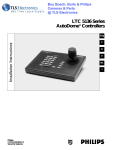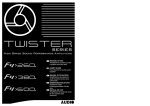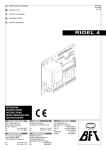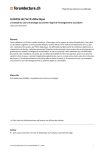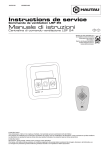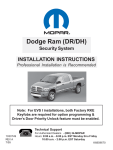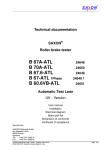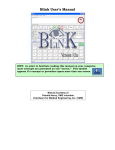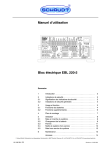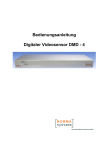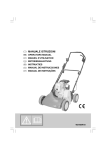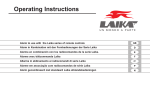Download MED AS3T IT_EN_FR_ES..
Transcript
1 9 0 8 4 8 4 4 0 A U T O M O T I V E S O LU T I O N S MED AS3 PROGRAMMARE DA PC CON PC PROGRAMMING ONLY WITH PROGRAMMATION PC AVEC PROGRAMAR SOLO CON PROGRAMMIERUNG ÜBER PC MIT SW MED 3.2.3 con numero di matricola superiore a with serial number higher than avec numéro de fabrication SUPERIEUR à para centralitas con S/N a partir de mit Matrikelnummer größer als 2021000000 ATTIVATORE SATELLITARE con interfaccia “CAN” SATELLITE ACTIVATOR with “CAN” interface ACTIVATEUR SATELLITAIRE avec interface “CAN” ACTIVADOR DE SATÉLITE con interfaz “CAN” STEUERZENTRALE FÜR SATELLITENARME mit CAN-Bus Interface ISTRUZIONE DI MONTAGGIO E FUNZIONAMENTO - ITALIANO ASSEMBLY AND USER’S GUIDE - ENGLISH INSTRUCTIONS DE MONTAGE ET DE FONCTIONNEMENT-FRANÇAIS INSTRUCCIONES DE MONTAJE - DE FUNCIONAMIENTO - ESPAÑOL EINBAUANLEITUNG - DEUTSCH A U T O M O T I V E S O LU T I O N S med S.p.A. a socio unico www.medautomotive.it Via Raffaello, 33 - 42100 Reggio Emilia - Italy - tel.+39 0522 500111 fax +39 0522 500153 e-mail: [email protected] QUALITY MANAGEMENT SYSTEM CERTIFIED BY DNV ISO/TS 16949:2002 MED AS3 LED NUMERO DI OMOLOGAZIONE e TYPE APPROVAL NUMBER e NUMERO HOMOLOGATION e NUMERO DE HOMOLOGACIÓN e ZULASSUNGSNUMMER e CAV 1001 ALIMENTAZIONE - FEEDING - ALIMENTATION - ALIMENTACION - ZUFUEHRUNG CAV AS3 T POSITIVO DIRETTO - POSITIVE DIRECT POSITIF DIRECT - POSITIVO DIRECT - DAUERPLUS +30 ROSSO - RED - ROUGE - ROJO - ROT NERO - BLACK - NOIR - NEGRO - SCHWARZ GND - NEGATIVO DA BATTERIA O DA TELAIO SU PREDISPOSIZIONE ORIGINALE - NEGATIVE TERMINAL FROM BATTERY OR FROM A GROUNDING POINT ON THE CHASSIS FRAME MADE BY THEVEHICLE MANUFACTURER 12V - NEGATIF DE BATTERIE OU DU CHASSIS SUR INSTALLATION D’ORIGINE -NEGATIVO DE LA BATERIA O AL CHASIS EL LA PREDISPOSICION ORIGINAL - DER (-) MASSEPOL DER BATTERIE ODER DES FAHRGESTELLS AUFDER ORIGINELLEN ANLAGE +15 ARANCIONE - ORANGE - ORANGE - ANARANJADO - ORANGE - POSITIVO SOTTO QUADRO PERMANENTE IN AVVIAMENTO - IN ALCUNI VEICOLI CON LINEA CAN IL [+15] PUO’ ESSERE RILEVATO DIRETTAMENTE - POSITIVE UNDER PERMANENT PANEL ON STARTING - IN SOME VEHICLE WITH CAN LINE [+15] CAN BE RECOGNIZED DIRECTLY - POSITIF SOUS CONTACT PERMANENT AU DEMARRAGE - EN CERTAINES VEHICULES AVEC LIGNE CAN [+15] PEUT ETRE RELEVE DIRECTEMENT - POSITIVO BAJO PANEL PERMANENTE DURANTE EL ARRANQUE - EN ALGUNOS VEHICULOS CON LINEA CAN EL [+15] PUEDE SER DETECTADO DIRECTAMENTE - ZÜNDUNGSPLUS; (+) AUCH WÄHREND DES STARTVORGANGS - BEI EINIGEN FAHRZEUGEN MIT CAN-LINIE KANN DER [+15] DIREKT ERMITTELT WERDEN VIOLA - PURPLE - VIOLET - VIOLETA - VIOLETTE ODOMETRO (SEGNALATORE DI VELOCITA’) RILEVATO TRAMITE LINEA CAN OPPURE IMPULSO DI 1 SECONDO ALL’INSERIMENTO DEL SISTEMA (CHIUSURA VEICOLO) ODOMETER (SPEED SENSOR) DETECTED ON CAN LINE OR 1 SECOND IMPULSE WHEN SYSTEM TURNED ON (VEHICLE CLOSED) ODOMÈTRE (INDICATEUR DE VITESSE) RELEVÉ PAR UNE LIGNE CAN OU BIEN PAR UNE IMPULSION D'UNE SECONDE LORS DE L'ACTIVATION DU SYSTÈME (FERMETURE DU VÉHICULE) TACOMETRO (MEDIDOR DE VELOCIDAD) RELEVADO POR LINEA CAN O IMPULSO DE 1 SEGUNDO A LA INGERENCIA DEL SISTEMA (ENCIERRO VEHICULO) HODOMETER (GESCHWINDIGKEITSMESSER) ÜBER CAN-LINIE ODER 1-SEKUNDEN-IMPULS BEI SYSTEMINITIALISIERUNG (VERSCHLIESSEN DES FAHRZEUGS) ERFASST MARRONE - BROWN - MARRON - MARRÓN - BRAUNE SEGNALE POSITIVO IN PRESENZA DI [+15] RILEVATO TRAMITE LINEA CAN SU VEICOLI PREDISPOSTI, OPPURE IMPULSO DI 1 SECONDO AL DISINSERIMENTO DEL SISTEMA (APERTURA VEICOLO) POSITIVE SIGNAL IN PRESENCE OF [+15] DETECTED ON CAN LINE ON EQUIPPED VEHICLES. OR 1 SECOND IMPULSE WHEN SYSTEM TURNED OFF (VEHICLE OPENED) SIGNAL POSITIF EN PRÉSENCE DE [+15] RELEVÉ PAR LIGNE CAN SUR LES VÉHICULES PRÉVUS À CET EFFET, OU BIEN IMPULSION D'UNE SECONDE LORS DE L'ACTIVATION DU SYSTÈME (OUVERTURE DU VÉHICULE) SEÑAL POSITIVO IN PRESENCIA DE [+15] RELEVADO POR LINEA CAN SOBRE VEHICULOS PREDISPUESTOS, O IMPULSO DE 1 SEGUNDO A LA DISINSERCION DEL SISTEMA (ABERTURA VEHICULO) POSITIV-SIGNAL IN PRÄSENZ VON [+15] BEI ENTSPRECHEND AUSGESTATTETEN FAHRZEUGEN ÜBER CAN-LINIE ODER 1-SEKUNDEN-IMPULS BEI SYSTEMDEAKTIVIERUNG (ÖFFNEN DES FAHRZEUGS) ERFASST 1 CAN ALTO - CAN HIGH - CAN HAUTE - CAN ALTO - CAN HIGH BLU/GIALLO - BLUE/YELLOW - BLEU/JAUNE - AZUL/AMARILLO - BLAU/GELB CAN BASSO - CAN LOW - CAN BAS - CAN BAJO - CAN LOW GIALLO - YELLOW - JAUNE - AMARILLO - GELB T - CAN ALTO - CAN HIGH - CAN HAUTE - CAN ALTO - CAN HIGH GIALLO/AZZURRO - YELLOW/LIGHT BLUE - JAUNE/BLEU AMARILLO/AZUL CLARO - GELB/HELLBLAU T - CAN BASSO - CAN LOW - CAN BAS - CAN BAJO - CAN LOW BLU - BLUE - BLEU - AZUL - BLAUE SEGNALE ANALOGICO - ANALOGICAL SIGNAL - SIGNAL ANALOGIQUE - SENAL ANALOGICA - ANALOGES SIGNAL GIALLO/ROSSO - YELLOW/RED - JAUNE/ROUGE - AMARILLO/ROJO - GELB/ROT SEGNALE ANALOGICO - ANALOGICAL SIGNAL - SIGNAL ANALOGIQUE - SENAL ANALOGICA - ANALOGES SIGNAL CAN-VAN-K-BUS O ALTRO - OR OTHER OU - AUTRE - O OTRO - ODER ETWAS ANDERES BLU/ROSSO - BLUE/RED - BLEU/ROUGE - AZUL/ROJO - BLAU/ROT GRIGIO - GREY - GRIS - GRIS - GRAUE USCITA DI STATO - STATUS EXIT - SIGNAL D’ETAT - SENAL DE ESTADO - ZUSATZLICHER AUSGANG GRIGIO/NERO - GREY/BLACK - GRIS/NOIR - GRIS/NEGRO - GRAU/SCHWARZE USCITA PULSANTI - BUTTONS EXIT - SORTIE BOUTONS - SALIDA PULSADORES - KNOEPFERSAUSGANG AZZURRO - LIGHT BLUE - BLEU CIEL - AZUL - HELLBLAUES - COLLEGAMENTO FACOLTATIVO PER PULSANTI PORTE, COFANO E BAULE NON RILEVATI DA CAN, VAN O K-BUS. INGRESSO VERSO IL NEGATIVO (MASSA). LIGHT BLUE - OPTIONAL CONNECTION FOR DOORS, BONNET AND BOOT BUTTONS NOT CONTROLLED BY CAN, VAN OR K-BUS. INPUT TOWARDS THE NEGATIVE SIGNAL (GROUND). - BRANCHEMENT FACULTATIF POUR LES BOUTONS DES PORTES, DU COFFRE ET DU CAPOT PAS DETECTES PAR LE CAN, LE VAN OU LE K-BUS. ENTREE VERS LE SIGNAL NEGATIF (MASSE). - CONEXION FACULTATIVA PARA PULSADORES PUERTAS, CAPO Y MALETERO NO ADVERTIDOS POR LINEA CAN, VAN O K-BUS. ENTRADA HACIA EL NEGATIVO (MASA). - FAKULTATIVE VERBINDUNG FUER DIE NICHT VON CAN,VAN ODER K-BUS ERHEBTE TUERENKOFFERRAUM-UND MOTORHAUBE- KNOPFER NICHT. UNMITTELBARER EINGANG GEGEN NEGATIV (MASSE). GND 2 ISTRUZIONE DI FUNZIONAMENTO UTENTE ITALIANO L’attivatore satellitare MED AS3 permette di pilotare un sistema di protezione satellitare, tramite il telecomando originale del veicolo, pertanto in modo estremamente semplice e pratico. Interpreta i segnali originali del veicolo ricevuti sia dalla linea seriale di trasmissione dati (quali, ad esempio: “CAN”, “VAN”, “K-BUS”, “CODE”) che da linee di tipo analogico, in segnali adatti ad essere utilizzati dal sistema di protezione satellitare abbinato, MEDSKY o di altro tipo. INSERIMENTO DEL SISTEMA Chiudere il veicolo col telecomando originale, come indicato dal costruttore del veicolo. Conferma: LED (spia rossa) acceso fisso per 1 secondo, poi lampeggiante lento a sistema inserito (un breve impulso ogni 3 secondi). Oppure, se impostata la funzione “RITARDO LETTURA PULSANTI PORTE”: LED acceso fisso per 30 secondi, poi lampeggiante lento a sistema inserito. A sistema inserito, l’apertura di una porta, del cofano o del baule, fa invertire al MED AS3 la modalità di lampeggio del LED: acceso fisso con brevissimi spegnimenti (1 ogni ogni 3 secondi). DISINSERIMENTO DEL SISTEMA Aprire le porte col telecomando originale, come indicato dal costruttore del veicolo. Per i veicoli col tasto separato di apertura baule: generalmente anche questo tasto permette di disattivare il sistema; su alcuni veicoli, a causa del funzionamento originale, occorre prima aprire le porte, poi il baule. Conferma: LED acceso fisso per 1 secondo, poi spento. RIFIUTO ALL'INSERIMENTO ! Con chiave quadro accesa, il sistema ignora l’inserimento (nessuna indicazione dal LED). ! Lampeggi molto veloci del LED indicano porta, cofano o baule aperti, se collegati all'ingresso pulsanti o rilevati tramite linea “CAN”, “VAN”, “K-BUS”, “CODE” ed è stata attivata la funzione “RIFIUTO INSERIMENTO A PORTE APERTE” unitamente al “SEGNALE APERTURA PULSANTI SEMPRE ABILITATO”. Chiudere la porta e reinserire il sistema. Se è stato impostato anche l’”INSERIMENTO ALLARME ALLA CHIUSURA PORTE”, appena tutte le porte sono chiuse, il sistema si inserisce autonomamente. - Se non è impostato il “RIFIUTO INSERIMENTO A PORTE APERTE” e la porta non viene chiusa, il sistema si INSERISCE ed invia la segnalazione di allarme. Il LED lampeggia come con sistema inserito(brevi accensioni del LED). Solo se la porta viene chiusa e riaperta, inverte la segnalazione. - Se viene impostato il “SEGNALE APERTURA PULSANTI SOLO A SISTEMA INSERITO (veicolo chiuso) e la porta non viene chiusa, il sistema si INSERISCE ed invia la segnalazione di allarme. ATTENZIONE: In questa modalità di funzionamento non è possibile attivare il “RIFIUTO INSERIMENTO A PORTE APERTE”. - Se viene impostato il “RITARDO LETTURA INGRESSO PORTE” e la porta non viene chiusa, il sistema si INSERISCE. Terminati i 30 secondi di ritardo, il sistema invia la segnalazione di allarme. ATTENZIONE: In questa modalità di funzionamento non è possibile attivare il “RIFIUTO INSERIMENTO A PORTE APERTE”. ATTENZIONE: ! L’ istruzione è riferita all'impianto completamente installato. ! L’esecuzione di alcune funzioni ne può escludere altre. ! La med s.p.a. si riserva la facoltà di apportare migliorie al prodotto senza preavviso. ! Il MED AS3 può essere impiegato sui veicoli a 24 Vdc col proprio riduttore di tensione KIT 24V/2. 3 PARTE RISERVATA ALL’INSTALLATORE PER L’ABBINAMENTO AL VEICOLO ED AL SISTEMA DI PROTEZIONE SATELLITARE ATTENZIONE: La modifica di questi parametri può pregiudicare il corretto funzionamento del sistema. Programmare col Personal Computer impiegando il software med versione 3.2.3 (o superiore) ed il cavetto KIT SK. ATTENZIONE: I pallini riportati in questa immagine indicano l’impostazione standard. 4 DESCRIZIONE FUNZIONI IMPOSTABILI DA PC COL SW MED: ATTENZIONE: L’impostazione delle funzioni sotto indicate dipende principalmente dalle caratteristiche del veicolo e del sistema di protezione satellitare abbinato. SEGNALE DI STATO “VEICOLO CHIUSO” Fornisce sul filo GRIGIO il segnale di attivazione NEGATIVO (negativo = veicolo chiuso, positivo = veicolo aperto) o POSITIVO (positivo = veicolo chiuso, negativo = veicolo aperto). ABILITA LETTURA CHIAVE QUADRO DA CAN BUS [+15] Questa funzione, abilitata all’origine, consente di rilevare direttamente il segnale del [+15], tramite la linea CAN nei veicoli predisposti (verificare sulla scheda di collegamento specifica del veicolo); se il segnale è disponibile, non collegare il filo ARANCIONE del MED AS3, ma isolarlo. In questo caso il filo MARRONE del MED AS3 fornisce un segnale positivo adatto a segnalarlo all’ingresso di un dispositivo elettronico con impedenza d’ingresso di almeno 47 KOhm. Se viene esclusa la lettura del [+15] dalla linea “CAN” originale del veicolo, o nel caso di veicolo non predisposto, collegare il filo ARANCIONE del MED AS3 ad un positivo sotto chiave quadro [+15], permanente in avviamento. ABILITA LETTURA VELOCITA’ DA CAN BUS Questa funzione, abilitata all’origine, consente di rilevare direttamente il segnale dell’ODOMETRO (misuratore di velocità), tramite la linea CAN, nei veicoli predisposti (verificare sulla scheda di collegamento specifica del veicolo). In questo caso il filo VIOLA del MED AS3 fornisce un segnale analogico proporzionale alla velocità alla quale sta viaggiando il veicolo. E’ anche possibile selezionare tramite il software med la scala di conversione del segnale, impostando la frequenza corrispondente ad 1 km/h, tra 1 e 10 hz. L’impostazione standard corrisponde alla frequenza di 7 hz per la velocità di 1 km/h. IMPULSI DI INSERIMENTO E DISINSERIMENTO (1 sec.) Permette di fornire un segnale di 1 secondo sul filo VIOLA all’inserimento del sistema e sul filo MARRONE al disinserimento. Si può scegliere la polarità: NEGATIVO o POSITIVO. ATTENZIONE: Funzione disponibile in modo completo solo disabilitando sia la “LETTURA CHIAVE QUADRO DA CAN BUS” che la “LETTURA VELOCITA’ DA CAN BUS”, altrimenti disabilitandone una sola possiamo avere un solo impulso: - all’inserimento, sul filo VIOLA, disabilitando la “LETTURA VELOCITA’ DA CAN BUS”; - al disinserimento, sul filo MARRONE, disabilitando la “LETTURA CHIAVE QUADRO DA CAN BUS”. 5 APERTURA PULSANTI PORTE, COFANO E BAULE Può fornire sul filo GRIGIO/NERO (USCITA PULSANTI) un segnale a porta aperta: CONTINUO (per tutto il tempo che una o più porte restano aperte) o IMPULSIVO all’apertura della porta, della durata massima di 5 secondi (si interrompe se viene chiusa prima dei 5 secondi); si ripete solo se la porta viene chiusa e riaperta. Si può scegliere la polarità dell’uscita: NEGATIVO o POSITIVO. Il segnale è rilevato sia da linea digitale (”CAN”...) che analogica verso massa (filo AZZURRO). SEGNALE APERTURA PULSANTI PORTE, COFANO E BAULE Può essere “SEMPRE ABILITATO” (ogni volta che si apre una porta il filo GRIGIO/NERO - USCITA PULSANTI - fornisce il segnale di porta aperta, anche a sistema disinserito), oppure può essere fornito “SOLO A VEICOLO CHIUSO”. RIFIUTO INSERIMENTO A PORTE APERTE Se abilitato, non consente l’inserimento del sistema con porte aperte, onde evitare falsi allarmi. La segnalazione è costituita da lampeggi veloci del LED. Vedere “RIFIUTO ALL’INSERIMENTO”. ATTENZIONE: Attivabile solo col “SEGNALE APERTURA PULSANTI PORTE, COFANO E BAULE” impostato come “SEMPRE ABILITATO” ed il “RITARDO LETTURA INGRESSO PORTE” risulta “ESCLUSO”. INSERIMENTO AUTOMATICO ALLA CHIUSURA PORTE Funzione attivabile solo col “RIFIUTO INSERIMENTO A PORTE APERTE”. Se abilitato, dopo il segnale di “RIFIUTO INSERIMENTO A PORTE APERTE”, appena ha l’indicazione che tutte le porte sono chiuse, attiva autonomamente il sistema, senza ulteriore impiego del telecomando originale. ATTENZIONE: Su alcune vetture con tasto di apertura baule separato, l’attivazione di questa funzione può consentire l’inserimento automatico del sistema quando il baule viene richiuso. PRE-ALLARME Ritarda l’invio della segnalazione di “PORTAAPERTA” di 8 / 10 secondi. Funzione consigliata solo sui veicoli senza linea digitale (CAN...), con impianto analogico che richiede la verifica di vari segnali per gestire correttamente il disinserimento del sistema, evitando sabotaggi dell’impianto o false segnalazioni di allarme (ad esempio coi programmi di interfacciamento che utilizzano il lampeggio frecce originale). RITARDO LETTURA INGRESSO PORTE Attivando questa funzione, i pulsanti porte, cofano e baule vengono “rilevati” solo 30 secondi dopo l’inserimento del sistema. Vedere “RIFIUTO ALL’INSERIMENTO”. 6 USER'S INSTRUCTION MANUAL ENGLISH The MED AS3 satellite activator allows you to control a satellite protection system, using the vehicle's original remote control, and therefore, in an extremely simple and practical way. It interprets the vehicle's original signals received from the serial data transmission line (such as, for example: “CAN”, “VAN”, “K-BUS”, “CODE”) and from lines of the analogical sort, in signals that are suitable to be used by the matched satellite protection system, MEDSKY or another type. SYSTEM ACTIVATION Lock the vehicle using the original remote control, according to vehicle manufacturer's instructions. Confirmation: LED (red pilot light) lit for 1 second, then slow flashing when system armed (a short pulse every three seconds). Or, if the “DELAYED READING OF DOOR SWITCHES” function is set: LED permanently lit for 30 seconds, then slow flashing when system armed. With the system armed, opening the door, bonnet or boot makes the MED AS3 invert the way the LED flashes: permanently lit with short cut outs (1 every 3 seconds). SYSTEM DESACTIVATION Open the doors using the original remote control, according to vehicle manufacturer's instructions. For vehicles with a separate boot-opening switch: - this switch also generally allows the system to be disarmed; - due to the original function procedure, on some vehicles you need to open the doors first, then the boot. Confirmation: LED is lit for 1 second and then goes out. DENIAL ON ACTIVATION ! With contact key in on position, the system ignores the arming (no signal from LED). ! Very fast flashing of the LED indicates that the door, bonnet or boot are open, if connected to the switch input or detected via the “CAN”, “VAN”, “K-BUS”, “CODE” line and the “ARMING REFUSAL WITH DOORS OPEN” function has been activated together with the “SWITCH OPENING SIGNAL PERMANENTLY ENABLED”. Close the door and rearm the system. If the “ALARM ARMING WHENS DOORS CLOSED” setting has also been set, the system is armed automatically, as soon as all the doors are closed. - If the “ARMING REFUSAL WITH DOORS OPEN” setting has not been set and the door is not closed, the system is ARMED and sends an alarm signal. The LED flashes in the same way as when the system is armed (short flashes of the LED). The signal is inverted, only if the door is closed and reopened. - If the “SWITCH OPENING SIGNAL ONLY WITH THE SYSTEM ARMED” (vehicle closed) setting has been set and the door is not closed, the system is ARMED and sends an alarm signal. WARNING: when this function procedure is used it is not possible to activate the “ARMING REFUSAL WITH DOORS OPEN” setting. - If the “DELAYED READING AT DOOR ENTRY” setting has been set and the door is not closed, the system is ARMED. After the delay of 30 seconds, the system sends the alarm signal. WARNING: when this function procedure is used it is not possible to activate the “AMING REFUSAL WITH DOORS OPEN” setting. WARNING: ! ! ! ! 7 These instructions are referred to the system completely installed. Some functions could cut out others. med s.p.a. reserves the right to bring any kind of improvements without previous notice. The MED AS3 can be installed in 24 Vdc vehicles with the KIT 24V/2 potential divider. PART RESERVED FOR THE INSTALLER FOR MATCHING UP WITH THE VEHICLE AND THE SATELLITE PROTECTION SYSTEM WARNING: Any modification to these parameters may compromise the correct functioning of the system. Program the system with a Personal Computer using med software Version 3.2.3 (or later version) and the SK KIT lead cable. WARNING: The choices selected in this figure indicate standard settings. 8 DESCRIPTION OF FUNCTIONS THAT CAN BE SET WITH A PC USING MED SOFTWARE: WARNING: The setting of the functions shown below depends mainly on the characteristics of the vehicle and of the matched satellite protection system. “VEHICLE CLOSED” SIGNAL - (Armed state signal) It supplies on the GREY wire, the NEGATIVE activation signal (negative = vehicle closed, positive = vehicle open) or the POSITIVE activation signal (positive = vehicle closed, negative = vehicle open). ENABLE READING OF KEY ON CODE FROM CAN BUS This function, enabled by default, allows the immediate detection of the [+15] signal using the CAN line on equipped vehicles (check the specific installation file for the vehicle); if the signal is available, do not connect MED AS3's ORANGE wire. Isolate it. In this case, MED AS3's BROWN wire supplies a positive signal suitable for indicating it to the input of an electronic device with input impedance of at least 47 Kohm. If the [+15] reading on the original CAN line of the vehicle is excluded, or if the vehicle is not equipped, connect MED AS3’s ORANGE wire to a positive ignition-on [+15], permanent on start-up. ENABLE READING OF SPEED VALUE FROM CAN BUS This function, enabled by default, allows the immediate detection of the ODOMETER (speed measurement) signal using the CAN line on equipped vehicles (check the specific connection file for the vehicle). In this case, MED AS3’s PURPLE wire supplies an analogical signal proportional to the speed of the vehicle. Using MED software, the signal conversion scale can be selected to set the frequency that corresponds to 1 km/h from 1 to 10 Hz. The standard setting is 7 Hz frequency for a speed of 1 km/h. ARMING AND DISARMING PULSES (1 sec.)-(Arming / disarming pulses (1 sec.)) Allows you to supply a 1 second signal on the VIOLET wire when the system is armed and on the BROWN wire when disarmed. You can choose a NEGATIVE or POSITIVE polarity. WARNING: This function is only fully active if the “ READING OF KEY ON CODE FROM CAN BUS” and “READING OF SPEED VALUE FROM CAN BUS” are both disabled; if only one is disabled, only one impulse is available: - When turned on, on the PURPLE wire when “READING OF SPEED VALUE FROM CAN BUS" is disabled. - When turned off, on the BROWN wire when “READING OF KEY ON CODE FROM CAN BUS" is disabled. 9 OPENING OF DOORS, BONNET AND TRUNK SWITCHES - (Doors, bonnet, trunk signal). It can provide a door open signal on the GREY/BLACK wire (SWITCH OUTPUT): CONTINUOUS (for the whole time that one or more doors are open) or PULSES when the door is opened, lasting for a maximum of 5 seconds (it is interrupted if it is closed before 5 seconds are up); it is repeated only if the door is closed and re-opened. You can choose a NEGATIVE or POSITIVE output polarity. The signal is detected along the digital line (“CAN” …) and the analogical line to ground (LIGHT BLUE wire). SIGNAL OF OPENING OF DOORS, BONNET AND TRUNK SWITCHES (Doors, bonnet, trunk switch signal) It can be “ALWAYS ACTIVATED” (every time a door is opened, the GREY/BLACK wire SWITCH OUPUT - provides a door open signal, even when the system is disarmed), or it can be supplied “ONLY WHEN VEHICLE CLOSED”. ARMING REFUSAL WITH DOORS OPEN - (No arming with open doors) If enabled, it does not allow the system to be armed with the doors open, so as to avoid false alarms. The signal consists of fast flashing of the LED. See “ARMING REFUSAL”. WARNING: Can be activated only with the “SIGNAL OF OPENING OF DOORS, BONNET AND TRUNK SWITCHES” set at “ALWAYS ACTIVATED” and the “DELAYED READING AT DOOR ENTRY” setting is “EXCLUDED”. AUTOMATIC ARMING WHEN DOORS ARE CLOSED - (Arming at doors closing) Function can be activated only with “ARMING REFUSAL WITH DOORS OPEN”. If enabled, after the “ARMING REFUSAL WHEN DOORS CLOSED” signal, as soon as it has the indication that all the doors are closed, the system activates automatically, without further use of the original remote control. WARNING: On some vehicles which have a separate boot opening switch, the activation of this function may allow the automatic arming of the system when the boot is closed again. PRE-ALARM - (Pre alarm) This delays the sending of the “DOOR OPEN” signal for 8/10 seconds. Function recommended only on vehicles without a digital line (CAN...), with an analogical system which requires the various signals to be checked so as to manage the disarming of the system correctly, avoiding tampering with the system or false alarm signals (for example with interface programmes which use original direction indicator flashing). DELAYED READING AT DOOR ENTRY - (Doors signal delay) By activating this function, the door, bonnet and boot switches are “detected” only 30 seconds after the system has been armed. See “ARMING REFUSAL”. 10 INSTRUCTIONS DE FONCTIONNEMENT UTILISATEUR FRANÇAIS L'activateur satellitaire MED AS3 permet de commander un système de protection satellitaire grâce à la radiocommande d'origine du véhicule, d'une façon qui est donc extrêmement simple et pratique. Il interprète les signaux d'origine du véhicule reçus par la ligne sérielle de transmission des données (comme, par exemple: “CAN”, “VAN”, “K-BUS”, “CODE”) et par les lignes de type analogiques, en signaux pouvant être utilisés par le système de protection satellitaire couplé MEDSKY ou d'un autre type. ACTIVATION DU SYSTEME Fermer le véhicule avec la radiocommande d'origine, comme indiqué par le constructeur du véhicule. Confirmation: LED (voyant rouge) lumière fixe pendant 1 seconde, puis clignotement lent une fois le système activé (une brève impulsion toutes les 3 secondes). Ou bien, si elle est configurée, la fonction “RETARD LECTURE BOUTONS PORTIERES”: LED lumière fixe pendant 30 secondes, puis clignotement lent lorsque le système est activé. Une fois le système activé, l'ouverture d'une portière, du capot ou du coffre provoque l'inversion, par le MED AS3, de la modalité de clignotement du LED: lumière fixe avec de très brèves coupures (1 toutes les 3 secondes). DESACTIVATION DU SYSTEME Ouvrir les portières avec la radiocommande d'origine, comme indiqué par le constructeur du véhicule. Pour les véhicules ayant une touche séparée pour l'ouverture du coffre: - généralement cette touche permet, elle aussi, de désactiver le système; - sur certains véhicules, en raison du fonctionnement d'origine, il faut d'abord ouvrir les portières, puis le coffre. Confirmation: LED lumière fixe pendant 1 seconde, puis éteinte. REFUS D'ACTIVATION ! Avec clé de contact tournée, le système ignore l'activation (aucune indication de la LED). ! Des clignotements très rapides de la LED indiquent que les portières, le capot ou le coffre sont ouverts, s'ils sont branchés sur l'entrée boutons ou relevés par la ligne “CAN”, “VAN”, “K-BUS”, “CODE” et que la fonction “REFUS D'ACTIVATION A PORTIERES OUVERTES” a été activée ainsi que le “SIGNAL OUVERTURE BOUTONS TOUJOURS HABILITE”. Fermer la portière et réactiver le système. S'il l' “ACTIVATION ALARME A LA FERMETURE DES PORTIERES” a été configurée, dès que toutes les portes sont fermées, le système se met automatiquement en fonction. - Si le “REFUS D'ACTIVATION A PORTIERES OUVERTES” n'est pas configuré et si la portière n'est pas fermée, le système s'ACTIVE et envoie la signalisation d'alarme. La LED clignote comme lorsque le système est actif (brefs allumages de la LED). Inversement de la signalisation, uniquement si la portière est fermée, puis réouverte. - Si le “SIGNAL D'OUVERTURE BOUTONS UNIQUEMENT A SYSTEME ACTIVE” est configuré (véhicule fermé) et si la portière n'est pas fermée, le système s'ACTIVE et envoie la signalisation d'alarme. ATTENTION: dans ce mode de fonctionnement il est impossible d'activer le “REFUS D'ACTIVATION A PORTIERES OUVERTES”. - Si le “RETARD DE LECTURE ENTREE PORTIERES” est configuré et si la portière n'est pas fermée, le système s'ACTIVE. Les 30 secondes de retard passées, le système envoie la signalisation d'alarme. ATTENTION: dans ce mode de fonctionnement il est impossible d'activer le “REFUS D'ACTIVATION A PORTIERES OUVERTES”. ATTENTION: ! Ces instructions se réfèrent au système installé complètement. ! L'exécution de certaines fonctions peut en exclure des autres. ! med s.p.a. se réserve le droit d'apporter des améliorations au produit sans préavis. ! Le MED AS3 peut être installée sur véhicules à 24 Vdc avec le réducteur de tension KIT 24V/2. 11 PARTIE RESERVEE A L'INSTALLATEUR POUR LE COUPLAGE AU VEHICULE ET AU SYSTEME DE PROTECTION SATELLITAIRE ATTENTION: La modification de ces paramètres peut nuire au bon fonctionnement du système. Programmer avec le Personal Computer en utilisant le logiciel med version 3.2.3 (ou supérieure) et le cordon KIT SK. ATTENTION: Les pastilles reportées sur cette image indiquent la configuration standard. 12 DESCRIPTION DES FONCTIONS CONFIGURABLES À PARTIR DU PC AVEC SW MED: ATTENTION: La configuration des fonctions indiquées ci-dessous dépend principalement des caractéristiques du véhicule et du système de protection satellitaire couplé. SORTIE D'ETAT “VEHICULE FERME” - (Signal d’état inséré) Fournit sur le fil GRIS le signal d'activation NEGATIF (négatif = véhicule fermé, positif = véhicule ouvert), ou POSITIF (positif = véhicule fermé, négatif = véhicule ouvert). LECTURE CLÉ DE CONTACT PAR CAN BUS [+15] Cette fonction, configurée à l'origine, permet de relever directement le signal du [+15], par la ligne CAN dans les véhicules prévus à cet effet (contrôler sur la fiche de connexion du véhicule); si le signal est disponible, ne pas brancher le fil ORANGE sur le MED AS3, mais l'isoler. Dans ce cas, le fil MARRON du MED AS3 fournit un signal positif apte à le signaler à l'entrée d'un dispositif électronique avec une impédance d'entrée d'au moins 47 KOhm. En cas d'exclusion de la lecture du [+15] par la ligne CAN d'origine du véhicule, ou si le véhicule n'est pas prévu pour, brancher le fil ORANGE sur le MED AS3 sous la clé de contact [+15], à un positif permanent lors de la mise en marche. LECTURE VITESSE PAR CAN BUS Cette fonction, configurée à l'origine, permet de relever directement le signal de l'ODOMÈTRE (capteur de vitesse), par ligne CAN, dans les véhicules prévus à cet effet (contrôler sur la fiche de connexion du véhicule). Dans ce cas, le fil VIOLET du MED AS3 fournit un signal analogique proportionnel à la vitesse à laquelle le véhicule est en train de se déplacer. Il est aussi possible de sélectionner l'échelle de conversion du signal à l'aide du logiciel MED, en réglant la fréquence correspondant à 1 km/h, entre 1 et 10 Hz. Le réglage standard correspond à la fréquence de 7 Hz pour une vitesse de1 km/h. IMPULSIONS D'ACTIVATION ET DE DESACTIVATION (1 seconde) (Impulsions en armement et désarmement) Permet de fournir un signal d'une seconde sur le fil VIOLET lors de l'activation du système et sur le fil MARRON lors de la désactivation. Possibilité de choisir la polarité: NEGATIVE ou POSITIVE. ATTENTION: Fonction entièrement disponible uniquement en désactivant aussi bien la « LECTURE CLÉ DE CONTACT PAR CAN BUS » que la « LECTURE VITESSE PAR CAN BUS », autrement, en en désactivant une seule, on obtient une seule impulsion: - lors de l'activation, sur le fil VIOLET, en désactivant la « LECTURE VITESSE PAR CAN BUS » ; - lors de la désactivation, sur le fil MARRON, en désactivant la « LECTURE CLÉ DE CONTACT PAR CAN BUS ». 13 OUVERTURE BOUTONS PORTIERES, CAPOT, ET COFFRE - (Signal en ouverture portes). Peut fournir sur le fil GRIS/NOIR (SORTIE BOUTONS) un signal à portière ouverte: CONTINU (pendant toute la durée pendant laquelle une ou plusieurs portières restent ouvertes) ou IMPULSIF lors de l'ouverture de la portière, d'une durée maximum de 5 secondes (s'interrompt si elle est fermée dans les 5 secondes); se répète uniquement si la portière est fermée puis réouverte. Possibilité de choisir la polarité de la sortie: NEGATIVE ou POSITIVE. Le signal est relevé par les deux lignes, numérique («CAN»…) et analogique vers la masse (fil BLEU CIEL). SIGNAL D'OUVERTURE BOUTONS PORTIERES, CAPOT ET COFFRE (Validation signal portes) Il peut être “TOUJOURS HABILITE” (à chaque ouverture de portière le fil GRIS/NOIR SORTIE BOUTONS fournit le signal de portière ouverte, même lorsque le système est désactivé) ou bien il peut être fourni “UNIQUEMENTA VEHICULE FERME”. REFUS D'ACTIVATION A PORTIERES OUVERTES - (Refus d’activation à portes ouvertes) S'il est habilité, il ne permet pas l'activation du système lorsque les portières sont ouvertes, pour éviter de fausses alertes. La signalisation est constituée par des clignotements rapides de la LED. Voir “REFUS D'ACTIVATION”. ATTENTION: Activable uniquement avec le “SIGNAL D'OUVERTURE BOUTONS PORTIERES, CAPOT ET COFFRE” configuré comme “TOUJOURS HABILITE” et le “RETARD LECTURE ENTREE PORTIERES” sur “EXCLU”. ACTIVATION AUTOMATIQUE DE LA FERMETURE DES PORTIERES (Activation automatique a la fermeture portes) Fonction activable uniquement avec le “REFUS D'ACTIVATION A PORTIERES OUVERTES”. S'il est habilité, après le signal de “REFUS D'ACTIVATION A PORTIERES OUVERTES”, dès qu'il a l'indication que toutes les portières sont fermées, il active automatiquement le système, sans besoin d'utiliser la radiocommande d'origine. ATTENTION: Sur certaines voitures ayant une touche d'ouverture coffre séparée, la mise en service de cette fonction peut permettre l'activation automatique du système lorsque le coffre est refermé. PRE-ALARME - (Pre-alarme) Retarde l'envoi de la signalisation de “PORTIERE OUVERTE” de 8 à 10 secondes. Fonction conseillée uniquement sur les véhicules sans ligne numérique (CAN...), avec système analogique demandant la vérification des différents signaux pour gérer correctement la désactivation du système, en évitant les sabotages de l'installation ou les faux signaux d'alarme (par exemple avec les programmes d'interfaçage qui utilisent le clignotement d'origine des clignotants). RETARD LECTURE ENTREE PORTIERES - (Retard lecture entree portieres) En activant cette fonction, les boutons des portières, du capot et du coffre sont “relevés” 30 secondes seulement après l'activation du système. Voir “REFUS D'ACTIVATION”. 14 INSTRUCCIONES DE FUNCIONAMIENTO PARA EL USUARIO ESPAÑOL El activador de satélite MED AS3 permite pilotar un sistema de protección a través de satélite mediante el mando a distancia original del vehículo; se trata de un sistema muy sencillo y práctico. Interpreta las señales originales del vehículo recibidas tanto desde la línea serial de transmisión de datos (como, por ejemplo: “CAN”, “VAN”, “K-BUS”, “CODE”) como desde líneas de tipo analógico, y las convierte en señales idóneas para que pueda utilizarlas el sistema de protección por satélite acoplado, MEDSKY o de otro tipo. ACTIVACIÓN DEL SISTEMA Cerraremos el vehículo con el mando a distancia original, tal como indica el fabricante del mismo. Confirmación: El LED (piloto rojo) se enciende fijo durante 1 segundo y después parpadea lentamente una vez activado el sistema (un breve impulso cada 3 segundos). O bien, si está programada la función “RETRASO EN LA LECTURA DE LOS PULSADORES DE LAS PUERTAS”: El LED se enciende fijo durante 30 segundos y después parpadea lentamente una vez activado el sistema. Con el sistema activado, la apertura de una puerta, del capó o del maletero hace que el MED AS3 invierta la modalidad de intermitencia del LED: encendido fijo con breves interrupciones (1 cada 3 segundos). DESACTIVACIÓN DEL SISTEMA Abriremos las puertas con el control a distancia original, tal como indica el fabricante del vehículo. Para los automóviles con la tecla de apertura del maletero separada: - por lo general, esta tecla también permite la desactivación del sistema; - en algunos vehículos, debido al funcionamiento original, primero hay que abrir las puertas y después el maletero. Confirmación: El LED se enciende fijo durante 1 segundo y después se apaga. DENEGACIÓN DE LAACTIVACIÓN ! Con la llave insertada en el salpicadero, el sistema ignora la activación y el LED no indica absolutamente nada. ! Las intermitencias muy rápidas del LED indican que la puerta, el capó o el maletero están abiertos, si están conectados en la entrada de los pulsadores o si se detectan mediante una línea “CAN”, “VAN”, “K-BUS”, “CODE”, y si se ha activado la función “DENEGACIÓN DE LAACTIVACIÓN CON LAS PUERTAS ABIERTAS” junto con la “SEÑAL DE APERTURA PULSADORES HABILITADA EN TODO MOMENTO”. Cerrar la puerta y volver a activar el sistema. Además, si ha sido programada la ”ACTIVACIÓN DE LAALARMA DE CIERRE DE LAS PUERTAS”, cuando todas las puertas estén cerradas, el sistema se activará autónomamente. - Si no está programada la “DENEGACIÓN DE LA ACTIVACIÓN CON PUERTAS ABIERTAS” y la puerta no se cierra, el sistema se ACTIVA y envía la señal de alarma. El LED parpadea, igual que ocurre con el sistema activado (breves encendidos del LED). Sólo invierte la señalización cuando la puerta se cierra y se vuelve a abrir. - Si se programa la “SEÑAL DE APERTURA DE LOS PULSADORES SÓLO CON EL SISTEMA ACTIVADO (vehículo cerrado) y la puerta no se cierra, el sistema se ACTIVA y envía la señal de alarma. ATENCIÓN: En esta modalidad de funcionamiento no se puede activar la “DENEGACIÓN DE LAACTIVACIÓN CON LAS PUERTAS ABIERTAS”. - Si se programma el “RETRASO DE LA LECTURA DE ENTRADA DE LAS PUERTAS” y la puerta no se cierra, el sistema se ACTIVA. Transcurridos los 30 segundos de retraso, el sistema envía la señal de alarma. ATENCIÓN: En esta modalidad de funcionamiento no se puede activar la “DENEGACIÓN DE LAACTIVACIÓN CON LAS PUERTAS ABIERTAS”. ATENCIÓN: ! Esta instrucción hace referencia a toda la instalación completada. ! La ejecución de algunas funciones puede excluir otras. ! La med s.p.a. se reserva la facultad de aportar mejoras al producto sin previo aviso. ! La MED AS3 puede emplearse en los vehículos de 24 Vdc con el reductor de tensión KIT 24V/2. 15 PARTE DIRIGIDA AL INSTALADOR PARA LA COMBINACIÓN CON EL VEHÍCULO Y CON EL SISTEMA DE PROTECCIÓN POR SATÉLITE ATENCIÓN: La modificación de estos parámetros puede perjudicar el correcto funcionamiento del sistema. Se programará con el Ordenador Personal empleando el software med versión 3.2.3 (o superior) y el cable KIT SK. ATENCIÓN: los puntos que aparecen en esta imagen indican la configuración estándar. 16 DESCRIPCIÓN DE LAS FUNCIONES CONFIGURABLES DESDE PC CON EL SW MED: ATENCIÓN: La configuración de las funciones indicadas a continuación depende sobre todo de las características del vehículo y del sistema de protección por satélite acoplado. SEÑAL DE ESTADO DE “VEHÍCULO CERRADO” - (Señal de estado “activado”) A través del cable GRIS pasa la señal de activación NEGATIVA (negativa = vehículo cerrado, positiva = vehículo abierto) o POSITIVA (positiva = vehículo cerrado, negativa = vehículo abierto). LECTURA LLAVE CUADRO POR CAN BUS [+15] Esta function, habilitada en origen, permite relevar directamente el senal del [+15], por la linea CAN en los vehiculos predispuestos (averiguar en el manual de conexion especifico del vehiculo); si el senal es disponible, no conectas el hilo ANARANJADO del MED AS3, si no lo aisles. En este caso el hilo MARRÓN del MED AS3 da un senal positivo apto para senalarlo a la entrada de un dispositivo electronico con impedancia de entrada de al menos 47 Kohm. Si viene excluida la lectura del [+15] por la linea “CAN” original del vehiculo, o si el vehiculo no està predispuesto, conectas el hilo ANARANJADO del MED AS3 a un positivo debajo de la llave cuadro [+15], permaneciente en arranque. LECTURA VELOCIDAD POR CAN BUS Esta funciòn, habilitada en origen, permite relevar directamente el senal del TACOMETRO (medidor de velocidad), por la linea CAN en los vehiculos predispuestos (averiguar en el manual de conexion especifico del vehiculo). En este caso el hilo VIOLETA del MED AS3 da un senal analogico proporcional a la velocidad en la que esta viajando el vehiculo. Es posible tambièn seleccionar a traves el software med la escalera de convercion del senal, planteando la frecuencia corespondente a 1 km/h, entre 1 y 10 hz. La impostaciòn standard coresponde a la frecuencia de 7 hz por la velocidad de 1 km/h. IMPULSOS DE ACTIVACIÓN Y DE DESACTIVACIÓN (1 segundo) - (Impulsos en conexión y desconexión) Transmite una señal de 1 segundo a través del cable VIOLETA en el momento de la activación del sistema y a través del cable MARRÓN en el momento de la desactivación. Cabe la posibilidad de elegir la polaridad: NEGATIVA o POSITIVA. ATENCION: Funciòn disponible de forma completa solo dishabilitando sea la “LECTURA LLAVE CUADRO POR CAN BUS” que la “LECTURA VELOCIDAD POR CAN BUS”, si no dishabilitando una sola de las dos solo podemos tener un impulso: - a la inserciòn, en el hilo VIOLETA, dishabilitando la “LECTURA VELOCIDAD POR CAN BUS”; - a la disinseciòn, en el hilo MARRÓN, dishabilitando la “LECTURA LLAVE CUADRO POR CAN BUS”. 17 APERTURA DE LOS PULSADORES DE LAS PUERTAS, DEL CAPÓ Y DEL MALETERO - (Señal de la apertura de las puertas) A través del cable GRIS/NEGRO (SALIDA DE PULSADORES) pasa una señal con la puerta abierta: CONTINUA (durante el tiempo que una o más puertas permanecen abiertas) o IMPULSIVA en el momento de la apertura de la puerta, con una duración máxima de 5 segundos (se interrumpe, si se cierra antes de 5 segundos); sólo se repite si la puerta se cierra y después se vuelve a abrir. Es posible elegir la polaridad de la salida: NEGATIVA o POSITIVA. La señal se obtiene tanto en la línea digital (”CAN”...) como en la analógica hacia masa (cable AZUL). SEÑAL DE APERTURA DE LOS PULSADORES DE LAS PUERTAS, DEL CAPÓ Y DEL MALETERO - (Señal pulsadores) Puede regularse para estar siempre “en servicio” (cada vez que se abre una puerta, el cable GRIS/NEGRO SALIDA DE LOS PULSADORES proporciona la señal de puerta abierta, incluso con el sistema desactivado), o bien para que esté en servicio “SOLO CON EL VEHÍCULO CERRADO”. DENEGACIÓN DE LA ACTIVACIÓN CON LAS PUERTAS ABIERTAS (Aviso puerta abierta) Si está habilitada, no permite la activación del sistema con las puertas abiertas para evitar falsas alarmas. La señalización consiste en una serie de intermitencias rápidas del LED. Véase el punto “DENEGACIÓN DE LAACTIVACIÓN”. ATENCIÓN: Sólo puede activarse con la “SEÑAL DE APERTURA DE LOS PULSADORES DE LAS PUERTAS, DEL CAPÓ Y DEL MALETERO”, programada para que “SiEMPRE ESTÉ HABILITADA”; el “RETRASO DE LA LECTURA EN LA ENTRADA DE LAS PUERTAS” queda excluido. ACTIVACIÓN AUTOMÁTICA CON EL CIERRE DE LAS PUERTAS (Conexión al Cierre Automático) Esta función sólo puede activarse con la “DENEGACIÓN DE LAACTIVACIÓN CON LAS PUERTAS ABIERTAS”. Si está habilitada, tras la señal de “DENEGACIÓN DE LA ACTIVACIÓN CON LAS PUERTAS ABIERTAS”, cuando tiene la indicación de que todas las puertas están cerradas, activa autónomamente el sistema, sin necesidad de usar el mando a distancia original. ATENCIÓN: En algunos automóviles con la tecla de apertura del maletero separada, la activación de esta función puede permitir la puesta en marcha automática del sistema cuando el maletero se cierra nuevamente. ALARMA PREVIA - (Pre-alarma) Retrasa el envío de la señalización de “PUERTAABIERTA” unos 8 / 10 segundos. Esta función se aconseja sólo en vehículos que, en lugar de línea digital (CAN...), tienen una instalación analógica que exige la verificación de varias señales para gestionar correctamente la desactivación del sistema, evitando sabotajes de la instalación o falsas señales de alarma (por ejemplo, con los programas de interfaz que usan la intermitencia de los intermitentes original). RETRASO EN LA LECTURA DE LA ENTRADA DE LAS PUERTAS - (Señal de entrada retardada) Al activar esta función, los pulsadores de las puertas, el capó y el maletero sólo se “detectan” 30 segundos después de la activación del sistema. Véase el punto “DENEGACIÓN DE LA ACTIVACIÓN”. 18 BEDIENUNGSANLEITUNG DEUTSCH Mit der Steuerzentrale MED AS3 kann ein Satellitenalarmsystem über die Original-Fernbedienung des Fahrzeugs mitgesteuert werden. Das System konvertiert sowohl die Originalsignale des Fahrzeugs, die von der seriellen Datenübertragungsleitung (wie z.B. „CAN“, „VAN“, „K-BUS“, „CODE“) empfangen werden, als auch solche analoger Leitungen in Signale, die von dem jeweils verwendeten Satellitenalarmsystem (MEDSKY oder andere) erkannt werden. AKTIVIEREN DES SYSTEMS Verriegeln Sie das Fahrzeug gemäß Herstellerangaben mit der Original-Funkfernbedienung. Die LED (rote Leuchtanzeige) leuchtet für 1 Sekunde konstant und blinkt langsam, Bestätigung: sobald das System aktiv ist (kurze Blinksignale in Intervallen von 3 Sekunden). Oder, wenn das Alarmsystem auf „VERZÖGERTE ERFASSUNG TÜRTASTEN“ programmiert ist: Die LED leuchtet für 30 Sekunden konstant und blinkt langsam, sobald das System aktiv ist. Das Öffnen einer Tür, der Motorhaube oder des Kofferraums bei aktivem System bewirkt, dass das MED AS3K das Blinkintervall der LED umkehrt: konstantes Leuchten und kurzes Ausschalten in Intervallen von 3 Sekunden. DEAKTIVIEREN DES SYSTEMS Entriegeln Sie das Fahrzeug gemäß Herstellerangaben mit der Original-Funkfernbedienung. Bei Funkfernbedienungen mit separater Taste für die Kofferraumentriegelung: - generell kann das System auch mit dieser Taste deaktiviert werden; - bei einigen Fahrzeugen müssen erst die Türen und dann der Kofferraum entriegelt werden. Bestätigung: Die LED leuchtet für 1 Sekunde konstant und schaltet sich dann aus. SYSTEM KANN NICHT AKTIVIERT WERDEN ! Wenn die Zündung eingeschaltet ist (keine LED-Anzeige). ! Sehr schnelles Blinken der LED signalisiert, dass eine Tür, die Motorhaube oder der der Kofferraum geöffnet ist, die entsprechende Tür an den Tasteneingang angeschlossen ist oder über die „CAN“-, „VAN“-, „K-BUS“- oder „CODE“-Leitung erfasst wurde sowie sowohl die Funktion „KEINE AKTIVIERUNG BEI GEÖFFNETEN TÜREN“ als auch die Funktion „ÖFFNUNGSSIGNAL TASTEN IMMER AKTIV“ aktiviert wurde. Die Tür schließen und das System erneut aktivieren. Wurde auch die Funktion „ALARMAKTIVIERUNG BEIM SCHLIESSEN DER TÜREN“ eingestellt, aktiviert sich der Alarm automatisch, sobald alle Türen geschlossen werden. - Ist die Funktion „KEINE AKTIVIERUNG BEI GEÖFFNETEN TÜREN“ eingestellt und die Tür wird geschlossen, AKTIVIERT sich das System und löst einen Alarm aus. Die LED blinkt wie bei aktiviertem System (kurzes Aufleuchten). Nur wenn die Tür geschlossen und wieder geöffnet wird, kehrt sich das Signal um. - Ist die Funktion „ÖFFNUNGSSIGNAL TASTEN NUR BEI AKTIVIERTEM SYSTEM“ (Fahrzeug verriegelt) eingestellt und die Tür wird nicht geschlossen, AKTIVIERT sich das System und löst einen Alarm aus. ACHTUNG: In diesem Betriebsmodus kann die Funktion „KEINE AKTIVIERUNG BEI GEÖFFNETEN TÜREN“ nicht gewählt werden. - Ist die Funktion „VERZÖGERTE ERFASSUNG EINGANG TÜREN“ eingestellt und die Tür wird geschlossen, aktiviert sich das System. Nach Verstreichen der 30 Sekunden Verzögerung wird ein Alarm ausgelöst. ACHTUNG: In diesem Betriebsmodus kann die Funktion „KEINE AKTIVIERUNG BEI GEÖFFNETEN TÜREN“ nicht gewählt werden. ACHTUNG: ! Die Anleitung bezieht sich auf komplett installierte Systeme. ! Die Ausführung bestimmter Funktionen kann die Nutzung anderer ausschließen. ! Das Unternehmen med S.p.A. behält sich das Recht vor, ohne Vorankündigung Produktverbesserungen vorzunehmen. ! An Fahrzeugen mit einer Bordspannung von 24 Volt DC kann das System MED AS3 in Kombination mit dem spezifischen Abwärtstransformator KIT 24V/2 genutzt werden. 19 NUR FÜR DEN INSTALLATEUR KONFIGURIERUNG FÜR DEN FAHRZEUGTYP UND DAS SATELLITENALARMSYSTEM ACHTUNG: Die Änderung dieser Parameter können die korrekte Funktion des Systems beeinträchtigen. Nehmen Sie die Programmierung am PC mit der med-Software Version 3.2.3 (oder höher) und dem Kabel KIT SK vor. ACHTUNG: Die in der Abbildung dargestellten Punkte kennzeichnen die Standardkonfiguration. 20 BESCHREIBUNG DER MIT DER SOFTWARE VON MED AM PC KONFIGURIERBAREN FUNKTIONEN: ACHTUNG: Die Einstellung der nachstehend beschriebenen Funktionen ist von den Eigenschaften des jeweiligen Fahrzeugs und des verwendeten Satellitenalarmsystems abhängig. STATUSSIGNAL „FAHRZEUG VERRIEGELT“- (Zusätzlicher Ausgang aktiviert) Überträgt über das GRAUE Kabel das Aktivierungssignal NEGATIV (negativ = Fahrzeug verriegelt, positiv = Fahrzeug entriegelt) oder POSITIV (positiv = Fahrzeug verriegelt, negativ = Fahrzeug entriegelt). EINLESEN DES ZÜNSCHLÜSSELS ÜBER CAN BUS [+15] Diese werkseitig aktivierte Funktion ermöglicht die direkte Erfassung des [+15]-Signals über die CAN-Linie bei entsprechend ausgestatteten Fahrzeugen (auf dem spezifischen Anschlussschema des Fahrzeugs ersichtlich). Ist das Signal verfügbar, das ORANGE Kabel des MED AS3 nicht anschließen, sondern isolieren. In diesem Fall überträgt das BRAUNE Kabel des MED AS3 ein positives Signal, das sich für dessen Signalisierung am Eingang einer elektronischen Komponente mit Eingangsimpedanz von mindestens 47 KOhm eignet. Wird das Einlesen des [+15] von der Original-CAN-Linie des Fahrzeugs ausgeschlossen oder ist das Fahrzeug nicht entsprechend ausgestattet, das ORANGE Kabel des MED AS3 an einen [+15]-Positivanschluss der Zündung anschließen, der in der Startphase permanent aktiv ist. EINLESEN DER GESCHWINDIGKEIT ÜBER CAN BUS Diese werkseitig aktivierte Funktion ermöglicht die direkte Erfassung des Signals des HODOMETERS (Geschwindigkeitsmesser) über die CAN-Linie bei entsprechend ausgestatteten Fahrzeugen (auf dem spezifischen Anschlussschema des Fahrzeugs ersichtlich). In diesem Fall überträgt das VIOLETTE Kabel des MED AS3 ein analoges Signal, das zur Fahrgeschwindigkeit des Fahrzeugs proportional ist. Alternativ besteht die Möglichkeit, über die MED-Software den Maßstab für die Signalkonvertierung auszuwählen, indem die Frequenz zwischen 1 und 10 Hz eingestellt wird, die 1 km/h entspricht. Die Standardeinstellung ist 7 Hz für 1 km/h. AKTIVIERUNGS - UND DEAKTIVIERUNGSIMPULSE (1 Sek.) (Aktivierungs-Deaktivierungsimpulse) Option für die Übertragung eines Signals von 1 Sekunde auf das VIOLETTE Kabel bei der Aktivierung bzw. auf das BRAUNE Kabel bei der Deaktivierung des Systems. Die Polarität ist wählbar: NEGATIV oder POSITIV. ACHTUNG: Diese Funktion ist nur komplett verfügbar, wenn sowohl das “EINLESEN DES ZÜNDSCHLÜSSELS ÜBER CAN-BUS“ als auch das „EINLESEN DER GESCHWINDIGKEIT ÜBER CAN-BUS“ deaktiviert ist. Wird nur eine der Funktionen deaktiviert, kann nur ein Impuls empfangen werden: - Bei Systeminitialisierung am VIOLETTEN Kabel, wenn das „EINLESEN DER GESCHWINDIGKEIT ÜBER CAN-BUS“ deaktiviert wurde; - Bei Systemdeaktivierung am BRAUNEN Kabel, wenn das “EINLESEN DES ZÜNDSCHLÜSSELS ÜBER CAN-BUS“ deaktiviert wurde. 21 ÖFFNUNGSTASTEN FÜR TÜREN, MOTORHAUBE UND KOFFERRAUM (Impuls bei der Türöffnung) Option für die Übertragung eines Signals‚Tür offen' auf das GRAU/SCHWARZE Kabel (AUSGANG TASTEN): DAUERHAFT (für die gesamte Zeit, während der eine oder mehrere Türen offen bleiben) oder IMPULS für höchstens 5 Sekunden beim Öffnen einer Tür (wird unterbrochen, wenn die Tür vor Ablauf der 5 Sekunden geschlossen wird); das Signal wird nur wiederholt, wenn die Tür geschlossen und erneut geöffnet wird. Die Polarität des Ausgangs ist wählbar: NEGATIV oder POSITIV. Das Signal wird sowohl von der Digitalleitung („CAN“ …) als auch von der Analogleitung zur Masse (HELLBLAUES Kabel). SIGNAL ÖFFNUNGSTASTEN FÜR TÜREN, MOTORHAUBE UND KOFFERRAUM - (Aktivierung der Signale für Tueren, Motorhaube und Kofferraum) Dieses Signal kann auf „IMMER AKTIV“ (jedes Mal, wenn eine Tür geöffnet wird, überträgt das GRAU/SCHWARZE Kabel - AUSGANG TASTEN ein Signal‚ Tür offen') oder „NUR BEI VERRIEGELTEM FAHRZEUG“ eingestellt werden. KEINE AKTIVIERUNG BEI GEÖFFNETEN TÜREN - (Schaerfen bei offener Tuere nicht moeglich) Bei Einstellung dieser Option kann das System bei geöffneten Türen aktiviert werden, um falsche Alarme zu vermeiden. Die Signalisierung erfolgt durch schnelles Blinken der LED. Siehe SYSTEM KANN NICHTAKTIVIERT WERDEN ACHTUNG: Diese Funktion ist nur aktivierbar, wenn die Option „ÖFFNUNGSSIGNAL TASTEN TÜREN, MOTORHAUBE UND KOFFERRAUM“ auf „IMMER AKTIV“ und „VERZÖGERTE ERFASSUNG EINGANG TÜREN“ „AUSGESCHLOSSEN“ ist. AUTOMATISCHE AKTIVIERUNG BEIM SCHLIESSEN DER TÜREN - (Schärfen beim Schliessen der letzten Fahrzeugtüre) Diese Funktion kann nur in Kombination mit „KEINE AKTIVIERUNG BEI GEÖFFNETEN TÜREN“ eingestellt werden. Ist sie eingestellt, wird das System nach dem Signal „KEINE AKTIVIERUNG BEI GEÖFFNETEN TÜREN“ ohne weitere Betätigung der Fernbedienung automatisch aktiviert, sobald erfasst wurde, dass alle Türen geschlossen sind. ACHTUNG: Bei einigen Fahrzeugen, deren Funkfernbedienung mit einer separaten Taste für die Kofferraumentriegelung ausgestattet ist, ermöglicht diese Funktion die automatische Aktivierung des Alarmsystems beim Schließen des Kofferraums. VORALARM - (Voralarm) Verzögerung der Übertragung des Signals „TÜR OFFEN“ um 8-10 Sekunden. Die Einstellung dieser Funktion empfiehlt sich nur bei Fahrzeugen ohne Digitalleitung (CAN …) und mit analoger Anlage, die die Prüfung verschiedener Signale erfordert, um die Deaktivierung des Systems korrekt zu verwalten, um Sabotageversuchen oder Fehlalarmen vorzubeugen (z.B. mit Schnittstellenprogrammen, die das Blinksystem der Original-Blinkleuchten des Fahrzeugs verwenden). VERZÖGERTE ERFASSUNG EINGANG TÜREN - (Doors signal delay) Bei Auswahl dieser Funktion werden die Tastensignale der Türen, der Motorhaube und des Kofferraums erst 30 Sekunden nach der Aktivierung des Systems „erfasst“. Siehe SYSTEM KANN NICHTAKTIVIERT WERDEN. 22 CARATTERISTICHE TECNICHE: ITALIANO MED AS3 Tensione di alimentazione: Assorbimento di corrente: Campo di temperatura: Posizionamento: Protezione: Uscite con segnale NEGATIVO: Uscite con segnale POSITIVO: 12 Vdc (nominali) 8 / 16 Vdc da 9 a 16 mA da - 40 °C a + 85 °C in abitacolo IP 40 (IEC 529 1989) DIN 40050 EN 60529 0.7 A Per dispositivi con impedenza d’ingresso di almeno 47 Kohm ENGLISH TECHNICAL FEATURES: MED AS3 Supply voltage: Current draw: Temperature range: Positioning: Insulation: Output with NEGATIVE signal: Output with POSITIVE signal: 12 Vdc (rated) 8 / 16 Vdc from 9 to 16 mA from - 40°C to + 85°C in passenger compartment IP 40 (IEC 529 1989) DIN 40050 EN 60529 0.7 A For devices with input impedance of at least 47 KOhm FRANÇAIS CARACTERISTIQUES TECHNIQUES: MED AS3 Tension d'alimentation: Absorption de courant: Plage de température: Positionnement: Protection: Sorties avec signal NEGATIF: Sorties avec signal POSITIF: 12 Vdc (nominale) 8 / 16 Vdc de 9 à 16 mA de - 40°C à + 85°C dans l'habitacle IP 40 (IEC 529 1989) DIN 40050 EN 60529 0.7 A Pour dispositifs avec impédance d'entrée de 47 Kohm minimum ESPAÑOL CARACTERÍSTICAS TÉCNICAS: MED AS3 Tensión de alimentación: Consumo de corriente: Campo de temperatura: Ubicación: Protección: Salidas con señal NEGATIVA: Salidas con señal POSITIVA: 12 Vdc (nominal) 8 / 16 Vdc desde 9 hasta 16 mA desde - 40 °C hasta + 85 °C en el habitáculo IP 40 (IEC 529 1989) DIN 40050 EN 60529 0.7 A Para dispositivos con impedancia de entrada de 47 Kohm como mínimo DEUTSCH TECHNISCHE EIGENSCHAFTEN: MED AS3 Versorgungsspannung: Stromaufnahme: Temperaturbereich: Installation: Schutzgrad: Ausgänge mit NEGATIVEM Signal: Ausgänge mit POSITIVEM Signal: 23 8 / 16 V 9 bis 16 mA - 40 °C bis + 85 °C im Fahrgastraum IP 40 (IEC 529 1989) DIN 40050 EN 60529 0.7 A Für Geräte mit einer Eingangsimpedanz von mindestens 47 Kohm ITALIANO MANUTENZIONE - L’attivatore satellitare MED AS3 non richiede nessuna manutenzione. CONDIZIONI DI GARANZIA La garanzia tecnica ha durata di 24 mesi dalla data d'installazione, franco fabbrica, per le parti ritenute difettose ad insindacabile giudizio med. Sono escluse da tale forma di copertura spese di manodopera esterna ed ogni altro onere a qualsiasi titolo. OMOLOGAZIONI L’attivatore satellitare MED AS3 è stato omologato secondo la Direttiva Europea 95/54/CE riguardante la compatibilità elettromagnetica (interferenze e disturbi) col n. e1 02 4065 ATTENZIONE: L’attivatore MED AS3 è stato predisposto e messo a punto secondo le caratteristiche tecniche indicate nel Fascicolo Tecnico del prodotto, riepilogate nella Dichiarazione di Conformità e nelle Istruzioni di Funzionamento. La manomissione del prodotto, l’alterazione delle predette caratteristiche come pure un intervento sul funzionamento e sul collegamento diversi dalle Istruzioni di Installazione indicate nel manuale possono modificare le condizioni all’osservanza delle quali il prodotto è ritenuto omologato, con conseguente pericolo per la successiva commercializzazione del prodotto. ENGLISH MAINTENANCE - The MED AS3 is maintenance free. WARRANTY CONDITIONS The technical warranty has a duration of 24 months from the date of installation, ex-works, and covers those parts considered as defective only by med s.p.a. Any other external labor or extra costs are excluded. HOMOLOGATIONS - The central unit is homologated in compliance with the European Directive 95/54/EC concerning the electromagnetic compatibility (interferences and noises) under the following approval n. e1 02 4065 WARNING: The MED AS3 central units are projected and set according to the product technical brochure specifications indicated in the compliance statement and in the working instructions. Any product tampering or any changement in the a.m. features as well as any intervention in the working way or in the connection done without complying with the installing instructions can modify these conditions according which the product is homologated to, which can have consequences on the further product selling. FRANÇAIS ENTRETIEN - MED AS3 ne nécessite aucun entretien. CONDITIONS DE GARANTIE La garantie technique a une durée de 24 mois à partir de la date d'installation, départ usine, pour les pièces considérées défectueuses par le jugement de med seulement. Sont exclues de cette couverture les frais de main-d' oeuvre et toutes les autres charges à tout titre. HOMOLOGATIONS La centrale est homologuée conformément à la Directive Européenne 95/54/EC concernant la compatibilité électromagnétique (brouillages et perturbations) avec le numéro: e1 02 4065 ATTENTION Les centrales MED AS3 ont été projetées et réglées selon le caractéristiques techniques du fascicule technique du produit résumées dans la déclaration de conformité e dans les instructions de fonctionnement. L'altération du produit, des caractéristiques mentionnées ci-dessous comme une intervention sur le fonctionnement et sur les branchements différents des instructions d'installation indiquées dans le manuel peuvent modifier les conditions selon lesquelles le produit est homologué, avec des conséquence sur la commercialisation du produit. 24 ESPAÑOL MANTENIMIENTO - MED AS3 no requiere ningún tipo de mantenimiento. CONDICIONES DE GARANTÍA La garantía técnica tiene una duración de 24 meses desde la fecha de instalación, franco fábrica, para aquellas partes que el juicio incontrovertible de med s.p.a. considere defectuosas. En este tipo de cobertura, quedan excluidos los gastos de mano de obra externa y cualquier otro tipo de gasto. HOMOLOGACIONES La centralita MED AS3 ha sido homologada de acuerdo con la Directiva Europea 95/54/EC relativa de las pruebas de EMC con el n. e1 02 4065 ATENCIÓN: Las centrales de la serie MED AS3 se han preparado y puesto a punto según las características técnicas indicadas en el Manual Técnico del producto, que se recogen en la Declaración de Conformidad e Instrucciones de Funcionamiento. El mal uso del producto, así como la alteración de las características descritas, la modificación de su funcionamiento o modo de conexión que no se ajusten a las indicadas en las Instrucciones de Instalación del manual podrían modificar las condiciones de cumplimiento de las reglas de homologación a las que se ha sometido dicho producto, lo que conllevaría un peligro en su posterior comercialización. DEUTSCH WARTUNG: Die Steuerzentrale MED AS3 ist wartungsfrei. GARANTIEBEDINGUNGEN: Die Gewährleistung beträgt 24 Monate ab Installation, entsprechend den gesetzlichen Bestimmungen. Die Gewährleistung bezieht sich ausschließlich auf das Gerät, externe Kosten für Arbeitszeit bzw. Diagnose werden nicht übernommen. ZULASSUNGEN: Die Alarmzentrale MED AS3 wurde unter der Nr. e1 02 4065 gemäß Kfz-EMV-Richtlinie 95/54/EG (Störungen und Interferenzen) zugelassen. ACHTUNG Die Steuerzentrale MED AS3 wurde mit den im Produktdatenblatt angegebenen technischen Eigenschaften gebaut und eingerichtet, die in der Konformitätserklärung und in der Bedienungsanleitung aufgeführt sind. Die Manipulation des Produkts, die Änderung der genannten technischen Eigenschaften sowie Funktionsweisen und Anschlüsse, die von den im Handbuch angegebenen abweichen, können die Bedingungen verändern, die Grundlage für die Zulassung des Produkts sind, was die anschließende Vermarktung beeinträchtigen kann. Cod. 190.848.440 - Rev. 02 del 07/05/08 - Printed in Italy A U T O M O T I V E S O LU T I O N S med S.p.A. a socio unico www.medautomotive.it Via Raffaello, 33 - 42100 Reggio Emilia - Italy - tel.+39 0522 500111 fax +39 0522 500153 e-mail: [email protected] QUALITY MANAGEMENT SYSTEM CERTIFIED BY DNV ISO/TS 16949:2002 CERTIFICAT DE GARANTIE - CERTIFICADO DE INSTALACION - INSTALLATIONSZERTIFIKAT Je soussigné, El que suscribe, Hiermit:________________________________________________ Appareilleur CERTIFIE qu'il a executé PERSONNELLEMENT l'assemblage du DISPOSITIF décrit cidessus, conformément aux instructions du fabricant. Instalador CERTIFICA de haber efectuado PERSONALMENTE el montaje del DISPOSITIVO que se describe a continuación, respetando las Instrucciones del fabricante. Das INSTALLATIONSZERTIFIKAT belegt die korrekte Installation des beschriebenen ALARMSYSTEMS in Übereinstimmung mit den Einbauanweisungen des Herstellers. Description du VEHICULE - Descripción del VEHICULO - Beschreibung des FAHRZEUGS: MARQUE, MARCA, MARKE:________________________________________________________ TYPE, MODELO, MODELL:_________________________________________________________ NUMERO de SERIE, NUMERO de PLATA de matricula, Fahrgestellnummer:______________________ Description du DISPOSITIF - Descripción del DISPOSITIVO - Beschreibung der ALARMSICHERUNG: Type, Modelol, Modell Matricule, Matricula, Artikelnummer Coller les étiquettes adhésives fournies dans la confection dument remplies ainsi que le questionnaire. Colocar en los recuadros la etiqueta adhesiva suministrada con los datos indicados y completar el módulo. Die in der Packung befindlichen Klebeetiketten mit den aufgeführten Angaben in den Feldern aufkleben und das Formular ausfüllen. Installé à, Instalado en, Eingebaut in:_________________________________ Le, El, Am:__________ Adresse complète de l'appareilleur: CACHET, SELLO, STEMPEL: Dirección completa del instalador: Vollständige Anschrift des installateurs: ______________________________________ ______________________________________ ______________________________________ SIGNATURE, FIRMA DEL INSTALADOR, UNTERSCHRIFT: ______________________________________ AVERTISSEMENTS GENERAUX POUR L'UTILISATEUR: ! L'INSTALLATION doit etre exécutée par un PERSONNEL QUALIFIE, conformément aux instructions spécifiques. ! L’INSTALLATEUR doit remplir et signer ce CERTIFICAT D’INSTALLATION. La med s.p.a decline toute responsabilité et suspend la GARANTIE dans le cas d'utilisation impropre du produit ou d'une partie de celui-ci, d'endommagement ou d'accouplement à des dispositifs nonprévus. ADVERTENCIAS GENERALES PARA EL USUARIO: ! La INSTALACION la debe efectuar el PERSONAL ESPECIALIZADO, respetando las instalaciones específicas. ! El INSTALADOR DEBE entregarle al PROPIETARIO del vehículo este CERTIFICADO DE INSTALACION totalmente compilado y firmado, también. La empresa med s.p.a. declina cualquier responsabilidad y suspenderá la GARANTIA en caso de una utilización impropia del producto o de alguna parte del mismo, de manipulaciones indebidas o de una combinación con dispositivos que no hayan sido previstos. ALLGEMEINE HINWEISE FÜR DEN BENUTZER: ! D E R E I N B A U PA R T N E R M U S S d e m FA H R Z E U G H A LT E R d i e v o r l i e g e n d e EINBAUBESTÄTIGUNG, die auch als GARANTIEBESCHEINIGUNG des Produktes Gültigkeit hat, aushändigen. ! Im Falle einer unsachgemäßen Verwendung des Produkts, oder seiner Teile, seiner Modifikation oder Anschluss an nicht dafür vorgesehene Vorrichtungen, wird jegliche Haftung und Garantieleistung abgelehnt. S.V.P. ECRIRE TOUT EN MAJUSCULE - POR FAVOR ESCRIBIR EN LETRA DE IMPRENTA - BITTE IN BLOCKSCHRIFT SCHREIBEN CERTIFICATO DI GARANZIA - WARRANTY CERTIFICATE Il sottoscritto, Thendersigned:________________________________________________________ Installatore CERTIFICA di aver eseguito PERSONALMENTE il montaggio del DISPOSITIVO descritto qui di seguito, conformemente alle istruzioni del fabbricante. Installed CERTIFIES that the fitting of the DEVICE described below was carried out by him PERSONALLY, in accordance with the instructions of the manufacturer. Descrizione del VEICOLO - Description of the VEHICLE: MARCA, TRADEMARK:_____________________MODELLO, TYPE:_________________________ NUMERO di TARGA, PLATE NUMBER:__________________________________________ Descrizione del DISPOSITIVO - Description of the DEVICE: Modello, Type Matricola, Registration Applicare nei riquadri le etichette adesive fornite in confezione con i dati indicati e completare il modulo. Apply the supplied labels with the relevant data and complete the form. Installato a, Installed at: ___________________________________ Il, On: ____________________ Indirizzo completo dell'installatore, Full address of installer: ___________________________________ TIMBRO, STAMP ___________________________________ ___________________________________ AVVERTENZE GENERALI PER L'UTENTE: ! L'INSTALLAZIONE deve essere eseguita da PERSONALE QUALIFICATO, secondo le istruzioni specifiche. ! L'INSTALLATORE DEVE compilare e firmare il presente CERTIFICATO DI GARANZIA. La med s.p.a declina ogni responsabilità e sospende la GARANZIA in caso di utilizzo improprio del prodotto o di parte di esso, di manomissione o di abbinamento a dispositivi non previsti. GENERAL WARNINGS FOR THE USER: ! INSTALLATION must be conducted by QUALIFIED PERSONNEL and according to the instructions. ! THE INSTALLER HAS TO sign and fill this CERTIFICATE OF GUARANTEE. med s.p.a declines all responsibility and withdraws the GUARANTEE/WARRANTY in cases of: the improper use of the product or part there of, tampering with the product, its combination with devices for which it was not specifically designed. SI PREGA DI SCRIVERE IN STAMPATELLO - PLEASE WRITE IN BLOCK LETTERS A U T O M O T I V E S O LU T I O N S med S.p.A. a socio unico www.medautomotive.it Via Raffaello, 33 - 42100 Reggio Emilia - Italy - tel.+39 0522 500111 fax +39 0522 500153 e-mail: [email protected] QUALITY MANAGEMENT SYSTEM CERTIFIED BY DNV ISO/TS 16949:2002 Cod. 190.848.440 - Rev. 02 del 07/05/08 - Printed in Italy ___________________________________ FIRMA DELL'INSTALLATORE, SIGNATURE:































